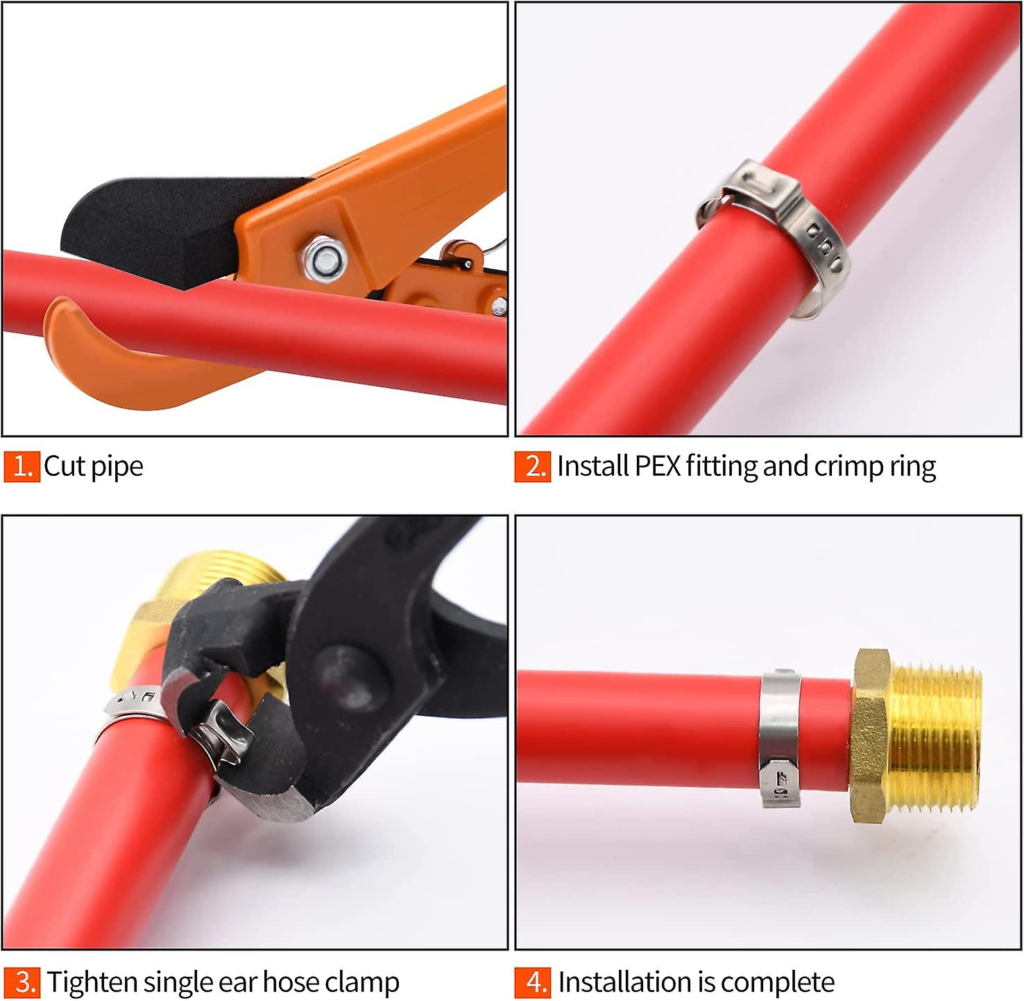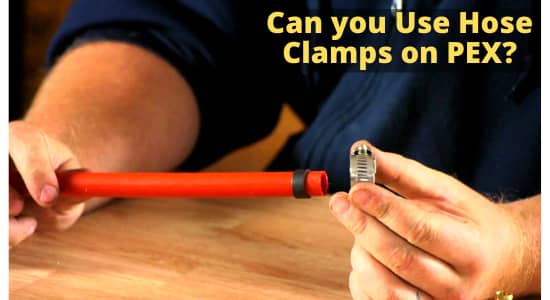Table of Contents
PEX (cross-linked polyethylene) is commonly used for plumbing applications domestically. It is well-suited for heating and water transmission purposes. It makes sense because the material is considerably cheaper compared to copper. Plus, it’s relatively easier to work with. But can you use hose clamps on pex Pipe?
Yes, you can use stainless steel hose clamps rather than crimp rings on PEX connections. Contrary to popular belief, clamps won’t loosen up and there will be no leakage. Plus, hose clamp installation is simple. You can use a cordless impact gun, ensuring you don’t over tighten the clamps.
However, if you want to know in detail about using Hose Clamps on PEX, stay tuned. In our following discussion, we will try to cover more facts related to the focus point.
Can You Use Hose Clamps on Pex Pipe?
Can hose clamps be used on PEX tubing? Yes, hose clamps can be used on PEX tubing. Traditionally, copper crimp rings are used to make connections to PEX pipe fittings. But they can be costly because a special crimping tool is required.
PEX tubing is manufactured in numerous sizes. The diameters range from 3/8” to 1”. You need the right sized crimp tool to tighten the respective crimp rings. This makes crimping a complicated and costly process.
But with hose clamps, you can use one tool for all clamp sizes. The tool is designed in such a way that the diameter of the ring is irrelevant. This is why most plumbers prefer hose clamps over the traditional crimp rings.
How to Install a Hose Clamp on PEX?
You will need the right tools to install a hose clamp on PEX pipes instead of the traditional crimp rings. Otherwise, you might end up with leakages or a frail connection between the pipes.
Before you begin, don’t make the mistake of using a cutting tool. It looks like the pinch clamp tool but there’s a reason why it is called a ‘cutting’ tool.
The tool can cut the ear when installed. Worst case scenario: it might cause the seal to fail because of scoring.

Here is a step-by-step guide to using a hose clamp:
Step 1: Calibration Comes First!
Use the calibrating tool before you slide the clamp onto the pipe. Most people tend to skip this step when installing hose clamps. But do you know why?
It is because they fail to realize that an incorrectly calibrated tool is highly likely to cause damaged fittings. You won’t see the damage until it’s too late!
Step 2: Expand the Hose Clamp
The hose clamp must be wide enough to slide over the PEX pipe. To expand the clamp, turn the screw anticlockwise until it is larger in diameter than the pipe and can smoothly slide over the PEX pipe.
Step 3: Locate the Fitting
Slide the widened clamp onto the PEX pipe. Locate the fitting to which you want to attach the clamp. Place the clamp over the joint between this fitting and the pipe.
Make sure the clamp is not positioned too close to the end of the pipe. We recommend placing it at least 4 mm away from the end.
Step 4: Screw Securely Into Place
To tighten the hose clamp, turn the screw clockwise, making sure it does not move from its original position. Contract the clamp until it can no longer slide on the fitting and the connection is secure.
You can use a ratchet type pinch clamp tool to help you. The tool holds the connection in place until the clamp is secured firmly.
PEX Crimps vs Hose Clamps: Which One’s Better?
Before you begin installing a hose clamp, it is important to understand the difference between PEX crimps and hose clamps.
Each method requires different tools. However, both methods create reliable connections that prevent leakages.
Stainless steel hose clamps are resistant to corrosion while copper crimp rings are not. Hence, hose clamps tend to be more durable compared to copper rings used for crimp connections. This makes them an ideal choice for plumbing applications.
Hose clamps are much easier to remove and do not damage the PEX pipe during the removal process while crimp rings cannot be removed once installed.
If you compare the costs of both methods, hose pipes are considerably cheaper. This is because clamping tools are much cheaper compared to crimping tools. Plus, finding the appropriate-sized crimping tool can be a hassle.
Video Instruction: Installation Hose Clamps On PEX Tubing
FAQs: Use Hose Clamps on PEX
Q1. Does Hose Clamp Size Matter?
Hose clamps are manufactured in a variety of sizes. You may be able to install an oversized clamp, but this leaves a sharp projection which increases the chances of injury.
When installing the appropriate-sized clamp, you could bend this sharp projection down. Or you could install a clamp finisher or jacket to envelope this sharp end.
Q2. How Tight Should the Hose Clamp Be?
To ensure the fitting stays in place, you need to achieve the correct tension. Since PEX pipes are sturdy and unbendable, you don’t need to be very concerned.
Don’t forget that the diameter of the band and the screw thread play a major role in determining the strength of the clamp.
Q3. How to Make a Tight Connection Without Using a Gauge?
You don’t need a gauge to make a tight connection. Instead, you can use a ratchet type pinch clamp tool which guarantees a properly formed connection. You can even visually inspect the connection when using non-ratcheting.
Q4. Is Crimping Easier Than Clamping?
Many experts and beginners prefer PEX crimping tools because they are much easier to use than clamps.
Clamping requires precision and skill but they can also be removed hose Clamp easily, allowing you to start over in case you’ve made a mistake.
READ ALSO: Which Type of PEX Fittings Are Best?
Conclusion:
There you’ve the solution: can i use a hose clamp on pex or not? Technically, with the right tools, procedures and expertise, you can use hose clamps on PEX. In most cases, hose clamps provide equally sturdy connections if the clamp is positioned correctly and tightened with appropriate force.
However, it depends on the situation. Did you find everything you needed to know about a hose clamp connection on PEX Pipes? If so, share the article with your fellow plumber friends.

